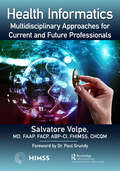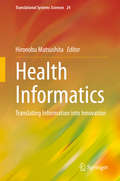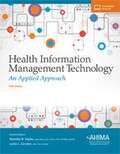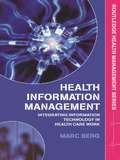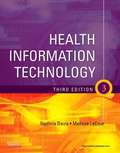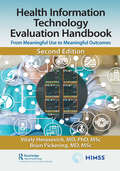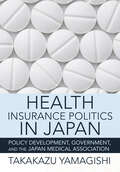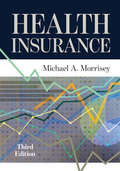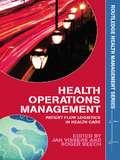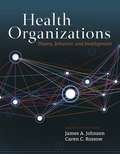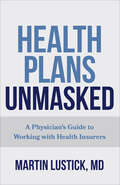- Table View
- List View
Health Informatics: Multidisciplinary Approaches for Current and Future Professionals (HIMSS Book Series)
by Salvatore Volpe"True wellness innovation requires the recruitment of multi-disciplinary participants. This book breaks the mold with examples from healthcare experts and other professionals who have leveraged informatics to better the lives of their constituents." — Jason Helgerson, Founder & CEO, Helgerson Solutions Group LLC Developed for those training in academic centers as well as for those already "out in the field," this book looks at how attorneys, behavioral health experts, business development experts, chief information officers, chief medical officers, chief nursing information officers, consumer advocates, cryptographic experts, futurists, geneticists, informaticists, managed care executives, nurses, pharmacists, physicians, public health professionals, software developers, systems security officers, and workforce experts are collaborating on a "team-based," IT-enabled approach to improve healthcare.
Health Informatics: Translating Information into Innovation (Translational Systems Sciences #24)
by Hironobu MatsushitaThis book is the first to approach healthcare informatics from the perspective of innovation. Drawing on the unique pairing of information and innovation, it offers an analysis to help readers rethink information technology, knowledge management, interprofessional collaboration and the generation of wisdom in the context of healthcare.The concept of “translational” research stems from the medical and health sciences, and features bidirectional and recursive information-generation processes involving bed-to-bench and bench-to-bed approaches. Based partly on this, translational systems science has become a new trend within systems sciences, motivated by the need for practical applications that help people by offering holistic systems solutions for complex ideas. Today, numerous innovations are emerging in diversified clinical practices, and there has been a remarkable convergence of new technologies in disciplines like genome therapy, immunotherapy, iPS cells, imaging diagnosis, personalized medicine, molecular targeted drugs, surgical robots, and remote nursing. Innovation is also occurring in health management fields, including health records, insurance reimbursement methods, quality control, and safety. In these areas, big data and machine learning are accelerating innovation. Behind these innovations are the creation, sharing, bridging, and translation of data, information, knowledge, and wisdom, and as such health informatics is critical in promoting health innovations.The book explores the horizons of health informatics, introducing cutting-edge practical cases and theoretical frameworks, including but not limited to fields such as big data, machine learning, drug discovery, interprofessional collaboration, electronic health records, robotics, telenursing, quality improvement, and safety.
Health Information Management Technology An Applied Approach 5th Edition
by Leslie L. Gordon Nanette B. SaylesCreates a blueprint for success in the health information management (HIM) field. Chapter content is expanded in the fifth edition to prepare students for transitional and changing roles in an electronic health information environment. All chapters are updated to reflect current HIM trends, practices, standards, and legal issues. Written by distinguished leaders in the field, this book guides students through two-year academic programs in preparation for the Registered Health Information Technician (RHIT) certification exam and beyond
Health Information Management: Integrating Information and Communication Technology in Health Care Work
by Marc BergIn almost all Western countries, concerted efforts are made to stimulate the use of information and communication technology (ICT) in health care. Yet the number of success stories are few and the frustrations many. In this key textbook, readers are introduced to the challenges, the lessons learned and the new insights of health information management at the start of the twenty-first century. With a strong international orientation, a comparative approach and a critical eye on many traditional information management views, the book illustrates key developments by drawing on examples from many different countries. Topics covered include: * Patient Care Information Systems* Integrating Quality Improvement* Information Strategy* Implementing Information SystemsFeaturing case studies and an overall practitioner's perspective, this key textbook combines theoretical backgrounds and starting points with practice-oriented guidelines and advice on the best methods for bringing these ideas to the challenges of everyday health care management. Original and refreshing, this textbook is essential reading for students of health care management and health care practitioners alike.
Health Information Technology
by Nadinia A. Davis Melissa LaCourReflecting emerging trends in today’s health information management, Health Information Technology, 3rd Edition covers everything from electronic health records and collecting healthcare data to coding and compliance. It prepares you for a role as a Registered Health Information Technician, one in which you not only file and keep accurate records but serve as a healthcare analyst who translates data into useful, quality information that can control costs and further research. This edition includes new full-color illustrations and easy access to definitions of daunting terms and acronyms. Written by expert educators Nadinia Davis and Melissa LaCour, this book also offers invaluable preparation for the HIT certification exam.
Health Information Technology Evaluation Handbook: From Meaningful Use to Meaningful Outcome (HIMSS Book Series)
by Vitaly Herasevich, MD, PhD, MSc Brian W. Pickering, MD, MScGovernments and clinical providers are investing billions of dollars in health information technologies. This is being done with the expectation that HIT adoption will translate into healthier patients experiencing better care at lower cost. As the first wave of adoption comes to an end, stakeholders are ready to evaluate the results of their investment and make decisions about future directions. As a result, structured evaluations of a projects impact are an essential element of the justification for investment in HIT. This book provides an easy-to-read reference outlining the basic concepts, theory, and methods required to perform a systematic evaluation of HIT.
Health Information Technology Evaluation Handbook: From Meaningful Use to Meaningful Outcomes (HIMSS Book Series)
by Vitaly Herasevich, MD, PhD, MSc Brian W. Pickering, MD, MScGovernments and clinical providers are investing billions of dollars in health information technologies (HIT). This is being done with the expectation that HIT adoption will translate into healthier patients experiencing better care at lower cost. In the initial push to roll out HIT, the reliability of these claims was often not substantiated by systematic evaluation and testing. As the first wave of widespread adoption of HIT comes to an end and the next wave begins, it is more important than ever that stakeholders evaluate the results of their investment, evaluate their success (or failure), and make decisions about future directions. Structured evaluations of a project’s impact are an essential element of the justification for investment in HIT. A systematic approach to evaluation and testing should allow for comparison between different HIT interventions with the goal of identifying and promoting those which improve clinical care or other outcomes of interest. The question of the day is no longer "why perform evaluations," but "how to perform evaluations." This updated book provides an easy-to-read reference outlining the basic concepts, theory, and methods required to perform a systematic evaluation of HIT. Chapters cover key domains of HIT evaluation: study structure and design, measurement fundamentals, results analysis, communicating results, guidelines development, and reference standards. Updated case studies and examples are included demonstrating the successes or failures of these investments. The authors also include new initiatives put in place by the government and discuss how they are being adopted and used by health systems.
Health Information: Management of a Strategic Resource (4th Edition)
by Mervat Abdelhak Sara Grostick Mary Alice HankenWritten for use in Health Information Management courses within the HIA curriculum, this text emphasizes the deployment of information technology and the role of the HIM professional in the development of the electronic health record.
Health Insurance
by Ermanno PitaccoHealth Insurance aims at filling a gap in actuarial literature, attempting to solve the frequent misunderstanding in regards to both the purpose and the contents of health insurance products (and 'protection products', more generally) on the one hand, and the relevant actuarial structures on the other. In order to cover the basic principles regarding health insurance techniques, the first few chapters in this book are mainly devoted to the need for health insurance and a description of insurance products in this area (sickness insurance, accident insurance, critical illness covers, income protection, long-term care insurance, health-related benefits as riders to life insurance policies). An introduction to general actuarial and risk-management issues follows. Basic actuarial models are presented for sickness insurance and income protection (i. e. disability annuities). Several numerical examples help the reader understand the main features of pricing and reserving in the health insurance area. A short introduction to actuarial models for long-term care insurance products is also provided. Advanced undergraduate and graduate students in actuarial sciences; graduate students in economics, business and finance; and professionals and technicians operating in insurance and pension areas will find this book of benefit.
Health Insurance
by Michael MorriseyRather than focus on the day-to-day operations of insurers, Health Insurance looks in from the outside and explains the role that private health insurance plays in the United States. Noted health economist Michael Morrisey presents a rigorous but intuitive examination of the issues raised by insurance and how the market and the government have dealt with these issues. His emphasis is on understanding the underlying problems from an economics perspective and then applying the empirical literature to provide insight into the impact and effectiveness of the solutions. As such, this book serves as a basis for understanding and predicting the effects of the Patient Protection and Affordable Care Act (ACA). This updated edition includes new chapters covering the ACA and the structure, conduct, and performance of the insurance market. Additional resources in each chapter include recent research articles and classic insurance papers that give readers further information on each topic.
Health Insurance Politics in Japan: Policy Development, Government, and the Japan Medical Association (The Culture and Politics of Health Care Work)
by Takakazu YamagishiJapan is the fastest aging country, with the largest super-aged society in the world and growing larger by the day, yet its universal health care costs are relatively low. In Health Insurance Politics in Japan, Takakazu Yamagishi draws back the curtain for an international audience and investigates how Japan has been able to control health care costs through health insurance politics.Covering the period from the Meiji Restoration to the Abe Administration, Yamagishi uses a historical institutionalist approach to examine the driving force behind the development of health insurance policies in Japan. Yamagishi pays special attention to the roles of government and medical professionals, the main actors of the policymaking and medical worlds, in this development. Health Insurance Politics in Japan pushes Japan into the spotlight of the international conversation about health care reform.
Health Insurance Reforms in Asia: Financial Pressures, Policy Initiatives And Popular Responses In Hong Kong, Shanghai And Singapore
by Sabrina Ching LukThis book empirically examines health care financing reforms and popular responses in three major cities in East Asia: Shanghai, Singapore, and Hong Kong. It adopts a new revised version of the theory of historical institutionalism to compare and explain the divergent reform paths in these three places over the past three decades. It also examines forces that propel institutional change. The book provides three detailed case studies on the development of health care financing reforms and the politics of implementing them. It shows that health care systems in Shanghai, Singapore, and Hong Kong were the products of Western presence in the nineteenth century. It illustrates how greater attention is paid to the roles played by ideas, actors, and environmental triggers without abandoning the core assumptions that political institutions and policy feedback remain central to impact health care financing reforms. It shows that health care financing reform is shaped by a complex interplay of forces over time. It also provides the most updated material about health care financing reforms in Shanghai, Singapore, and Hong Kong. The central argument of this book is that health care financing reform is both an evolving process responding to changing circumstances and a political process revealing an intricate interplay of power relationships and diverse interests. It shows that institutional changes in health care financing system can be incremental but transformative in nature. It argues that social policies will continue to develop and welfare states will continue to adapt and evolve in order to cope with new risks and needs. This book sheds new lights on understanding the politics of health care financing reform and sources and modes of institutional change.
Health Insurance Today: A Practical Approach
by Janet I. BeikHealth Insurance Today, A Practical Approach, 6th Edition gives you a solid understanding of health insurance, its types and sources, and the ethical and legal issues surrounding it. This new edition incorporates the latest information surrounding ICD-10, the Patient Protection and Affordable Care Act, and other timely federal influencers, as it guides you through the important arenas of health insurance such as claims submission methods, the claims process, coding, reimbursement, hospital billing, and more. Plus, with hands-on UB-04 and CMS-1500 (02-12) case studies on Evolve, you will come away with a clear understanding and working knowledge of the latest advances and issues in health insurance.
Health Insurance Today: A Practical Approach
by Janet I. BeikLearn to comprehend the complexities of health insurance! Using a reader-friendly approach, Health Insurance Today, A Practical Approach, 6th Edition gives you a solid understanding of health insurance, its types and sources, and the ethical and legal issues surrounding it. This new edition incorporates the latest information surrounding ICD-10, the Patient Protection and Affordable Care Act, and other timely federal influencers, as it guides you through the important arenas of health insurance such as claims submission methods, the claims process, coding, reimbursement, hospital billing, and more. Plus, with hands-on UB-04 and CMS-1500 (02-12) case studies on Evolve, you will come away with a clear understanding and working knowledge of the latest advances and issues in health insurance.
Health Insurance in the United States of America: Austrian Perspectives on Interventionism before ObamaCare (Routledge Focus on Economics and Finance)
by Łukasz JasińskiThe U.S. health care system is dominated by private and public (governmental) insurance which makes it difficult for many Americans to imagine access to health care without it. The health care system in the USA is sometimes mistakenly referred to as market-based, partly because of the previous lack of compulsory insurance.As this book shows, however, even before ObamaCare it was a system heavily influenced by the government. This short and accessible book demonstrates that governmental long-term interventionism in the American health insurance market has led to many contemporary serious problems, such as significant and uncontrolled increases in health care costs, rising health insurance prices, marginalization of direct payments, limited competition, and problems with uninsured Americans. Many observers wrongly blame the market for this state of affairs and demand more regulation, which further deteriorates the situation. The study is divided into two parts: an analysis of the history of interventions (and their effects) in the private health insurance market, and an analysis of the genesis and evolution of governmental Medicare and Medicaid insurance. Thus, the book constitutes a unique synthesis of Austrian theory of interventionism and the history of health insurance in the USA.This book is vital reading for health economists, managers, and policymakers, as well as those interested in the Austrian approach to economics.
Health Insurance, Third Edition (Aupha/hap Book Ser.)
by Michael A. MorriseyHealth insurance is the machinery that makes the financing of the US health system run. But what's going on under the hood? Health Insurance helps readers learn the underlying assumptions, facts, and variables that drive decision-making and choices on the payer side. Picking up where introductory economics courses often leave off, the book presents the foundational economic principles of health insurance to clarify insurance-related policy and management issues. Author Michael A. Morrisey clearly explains complex concepts such as adverse selection, moral hazard, managed care, and employer-sponsored health insurance. Also addressed are risk adjustment, demand, health savings accounts, selective contracting, the diversity of health insurance markets, and the functioning of Medicare and Medicaid. The book is distinguished by its in-depth discussion of research in health insurance, both cutting edge and classic. This third edition has been substantially revised to reflect the rapid evolution of the healthcare field stemming from the Affordable Care Act (ACA). Throughout, the most recent available data is used. Though health insurance has been a major player in the American healthcare system for decades, it's hardly static. This new edition of Health Insurance keeps pace with the changes, while also offering a thorough foundation on the basics.
Health Leads: Reaching for Impact (A)
by V. Kasturi Rangan Sarah ApplebyExplores strategies to achieve system-level impact for a nonprofit focused on addressing patients' basic social needs through healthcare institutions. Founded in 1996 with a volunteer-staffed help desk at Boston Medical Center connecting low-income patients with basic resources like heating assistance, job training, and childcare programs, by 2013 the nonprofit had grown to 6 cities and 1,000 volunteers serving over 11,000 patients annually. At the end of a successful "proof plan" period, Health Leads Co-Founder and CEO Rebecca Onie and her team faced the question of how to make meeting patients' social needs a standard part of health care in the U.S.: replicate Health Leads' proven model or instigate a social care movement?
Health Leads: Reaching for Impact (Abridged)
by V. Kasturi Rangan Sarah ApplebyA nonprofit in the healthcare arena explores strategies to achieve system-level impact. Founded in 1996 with a volunteer-staffed help desk at Boston Medical Center connecting low-income patients with basic resources like heating assistance, job training, and childcare programs, by 2013 the nonprofit had grown to 6 cities and 1,000 volunteers serving over 11,000 patients annually. At the end of a successful "proof plan" period, Health Leads Co-Founder and CEO Rebecca Onie and her team faced the question of how to make meeting patients' social needs a standard part of health care in the U.S.: replicate Health Leads' proven model or instigate a social care movement?
Health Leads: Reaching for Impact (B)
by V. Kasturi Rangan Sarah ApplebyThe B case documents the development of a strategy to achieve system-level impact in a rapidly changing healthcare landscape for a nonprofit focused on addressing patients' basic social needs through healthcare institutions. Founded in 1996 with a volunteer-staffed help desk at Boston Medical Center connecting low-income patients with basic resources like heating assistance, job training, and childcare programs, by 2013 the nonprofit had grown to 6 cities and 1,000 volunteers serving over 11,000 patients annually. At the end of a successful "proof plan" period, Health Leads Co-Founder and CEO Rebecca Onie and her team faced the question of how to make meeting patients' social needs a standard part of health care in the U.S.: replicate Health Leads' proven model or instigate a social care movement?
Health Operations Management: Patient Flow Logistics in Health Care
by Jan Vissers Roger BeechHealth operations management is defined as ‘the analysis, design, planning, and control of all of the steps necessary to provide a service for a client’. In other words, it is concerned with identifying the needs of clients, usually patients, and designing and delivering services to meet their needs in the most effective and efficient manner. Addressing this key healthcare industry challenge, this informative textbook crosses geographical boundaries to outline the logical steps of health operations management, focusing on the management of patient flows and resources. Until now, healthcare professionals, practitioners and students interested in this topical issue consulted general operations management textbooks, but with discussions of related fields (such as healthcare quality assurance and performance management) this dedicated volume now provides a much more relevant read. Featuring theoretical framework and practical case studies, this book also covers subjects such as hospital planning and supply chain management in healthcare, and will be a valuable reference for students and researchers in the fields of healthcare management, operations management and patient flow logistics.
Health Organizations: Theory, Behavior, and Development
by James A. Johnson Caren C. RossowOrganizations are complex human systems that have evolved over time and continue to do so in an increasingly globalized, information enriched, technology intensive era such as the 21st century. This is especially so following the Affordable Care Act legislation and regulations in the U.S. <p><p> The new Second Edition of Health Organizations: Theory, Behavior, and Development addresses these changes by integrating new content throughout every chapter and topic area. This book will help the student and practitioner put to use theories of organization and knowledge of organization behavior in ways that foster change in productive and sustainable ways resulting in better outcomes. Students will learn systematic planned approaches for organization development and team building and by examining power, influence, conflict, motivation, and leadership in the context of health service delivery. <p> The Second Edition introduces new elements including: chapter overviews; film learning exercises; key terms; case studies; chapter discussion questions; in-class exercises; online learning activities; key interviews with leaders and managers; appendix; study guide; and other supporting ancillaries.
Health Policy and the Public Interest
by Lok-sang HoThis book is written with an acute awareness of the need for new insight to ensure (1) universal protection in basic healthcare; (2) providing choice; (3) efficient production and consumption of healthcare services; (4) financial sustainability of the healthcare system. Defining the public interest as the welfare of the "representative individual" with no vested interest who imagines himself to have equal chance of being anyone in society, this book explores alternative ways of finance and delivery, the optimal interface between the public healthcare sector and the private healthcare sector, and that between public insurance and private insurance. The book includes a theoretical but non-technical section that distinguishes between the stock of health and functional health, proposes a utility maximizing/behavioural framework to explain behaviour and the role of health policy and investigates the nature of risk and alternative insurance mechanisms. The book illustrates with a number of country studies, covering a large range of healthcare systems from the American and the European systems to various Asian systems as well as those of Australia and New Zealand. The survey of country experiences reinforces the theoretical conclusions about the role of the public healthcare sector and social insurance and that of the private market. The book highlights the importance of and the workability of "pricing right" and "capping right": pricing standard or basic healthcare services at the right price can contain both demand-side and supply-side moral hazard and lead to more efficient production and consumption of healthcare services; capping annual eligible healthcare expenses will provide effective protection against financial risks. The proposal of lifetime healthcare supplement offers greater choice. Private caregivers and insurers supplement the public healthcare system by offering more choices and premium services, as well as additional protection.
Health Reform: Public Success, Private Failure (Routledge Studies in Governance and Change in the Global Era)
by Terry Sullivan Daniel DracheHealth Reform explores the challenges facing health care provision in the advanced economies. The book exposes the limitations of market-led health reform and demonstrates the indispensable role of a vibrant public authority in the renewal of modern health care systems. Issues covered include: * cost-containment and privatisation strategies in an international perspective * the role of business and the private sector in setting the agenda for health care reform * the restructuring of Anglo-Saxon health systems and the shift in state/market boundaries in Canada, the USA, the UK and Australia * the frontier of health care reform in terms of health and social cohesion *the role of patient choice in health care reform.
Health Research Governance in Africa: Law, Ethics, and Regulation (Biomedical Law and Ethics Library)
by Cheluchi Onyemelukwe-OnuobiaThe globalisation of research has resulted in the increased location of research involving humans in developing countries. Countries in Africa, along with China and India, have seen research grow significantly. With emerging infectious diseases, such as Ebola and Zika, emphasising the risk of public health crises throughout the world, a further increase in health research, including clinical research in developing countries, which are often the sites of these diseases, becomes inevitable. This growth raises questions about domestic regulation and the governance of health research. This book presents a comprehensive and systemic view of the regulation of research involving humans in African countries. It employs case studies from four countries in which research activities continue to rise, and which have taken steps to regulate health research activity: South Africa, Nigeria, Kenya, and Egypt. The book examines the historical and political contexts of these governance efforts. It describes the research context, some of the research taking place, and the current challenges. It also looks at the governance mechanisms, ranging from domestic ethical guidelines to legal frameworks, the strengthening of existing regulatory agencies to the role of professional regulatory bodies. The book analyses the adequacy of current governance arrangements within African countries, and puts forward recommendations to improve the emerging governance systems for health research in African and other developing countries. It book will be a valuable resource for academics, researchers, practitioners and policy-makers working in the areas of health research, biomedical ethics, health law and regulation in developing countries.
